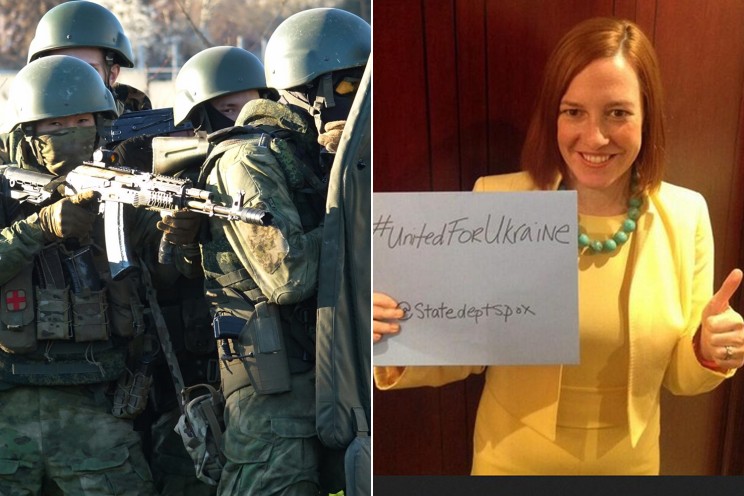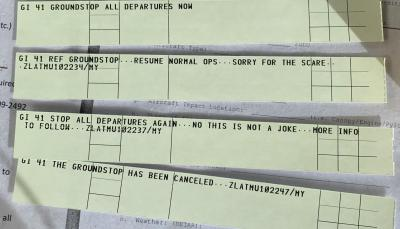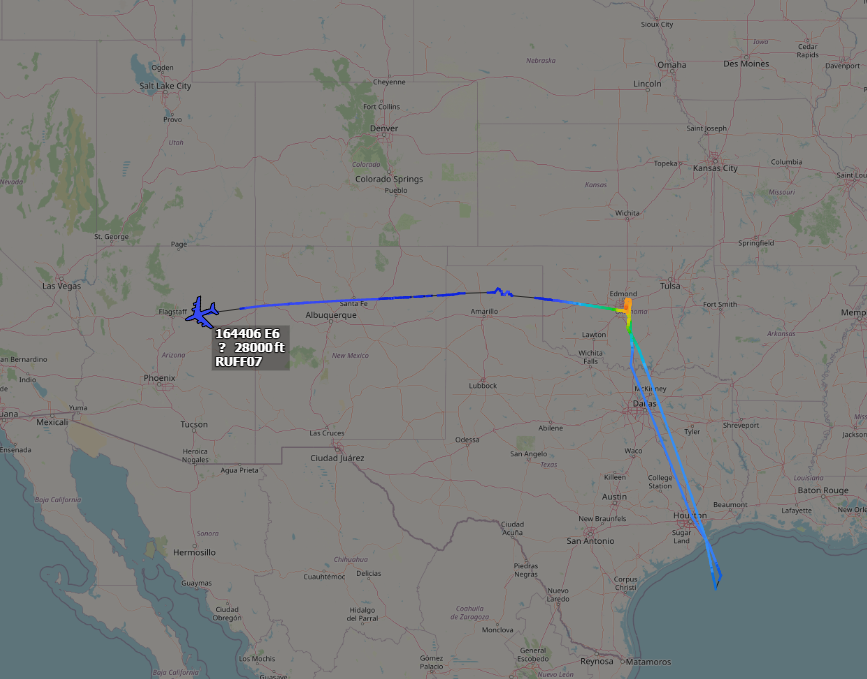Biden is committing combat troops to Eastern Europe. No word on if this guy is one of them:

Biden is committing combat troops to Eastern Europe. No word on if this guy is one of them:

With two oceans insulating us from Asia and Europe, along with friendly (and relatively weak) neighbors to the north and south, the United States has relied on the oceans as a buffer zone against hostile forces. Those oceans are the main reason why Americans haven’t seen a war in our cities in over 150 years.
In any conflict against the Russians, winning or losing will come down to how well we can get munitions, supplies, and reinforcements across the oceans.
Both of these facts mean that we need a Navy to protect the shores and to keep our sea lanes open.
During the cold war, the US had 15 carrier battlegroups. Now it has 10. A 1980s carrier battle group had the carrier, two cruisers, three destroyers, three frigates, and a pair of supply ships. (I am not counting the submarines as a part of the group, because they seldom stay close to the carrier. Besides, submarines are not there to keep sea lanes open, they are there to deny those sea lanes to others.)
The air wing of the 1980s consisted of an Airborne Early Warning Squadron flying E2 Hawkeyes, a pair of F14 squadrons flying the F14 Tomcat, a pair of attack squadrons flying the A-7 corsair, an ASW squadron flying the S-3 Viking, a squadron of A6 bombers and tankers, an Electronic Warfare squadron flying the EA6B prowler, an ASW helicopter squadron flying the SH-3 sea king. In all, there were 92 aircraft and 11 ships in a cold war carrier battle group. The aircraft back then had more than double the combat radius as today’s airwing. The battle group had a dedicated ASW capability that was far more capable than today.
Fast forward to today: The CBG has a much diminished ASW capability, and the group consists of the carrier, one cruiser, five destroyers, and a supply ship. The airwing still has 9 squadrons, but they are smaller than squadrons just 30 years ago and carry just 53 aircraft. The Navy has eliminated the submarine hunting S-3, and has combined the functions of the A-6, EA-6B, KA-6D, F-14, and A-7 into just one aircraft platform: the F/A-18.
It doesn’t do most of those jobs as well as the aircraft they replaced. The A-6F Intruder had a 16 ton payload (pdf alert). The A-7 Corsair could carry a 6.8 ton payload. The Hornet has a 4.5 ton payload.
The F/A-18 Hornet has a much shorter range than aircraft of the cold war. This means that the carrier group must get closer to potential adversaries, which is more dangerous.
As an example, the A-6 Intruder had a combat radius of 900 miles, the A7 a radius of 700 miles, the F-14 had a radius of 650 nautical miles. Compare that to the Hornet’s radius of only 330 nautical miles. Now the carrier has to get more than 300 miles closer to the enemy in order to conduct operations.
The CBG used to have the capability of carrying and delivering nuclear weapons. With the elimination of the carriers’ W division, and the elimination of the TLAM-N, that capability has been lost. The personnel who were trained to handle and load these weapons are gone, and it would take years to regain the knowledge and weapons.
I can hear it now- the forces we have are technologically more advanced, meaning that we don’t need as many ships and aircraft to do the job. While I agree that our platforms and weapons are more capable, so are the platforms and weapons of any near peer enemy. Russian and China have stealth platforms. They have long range missiles. They have hypersonic weapons. So I don’t think we can rely on a technology edge to the point where we can do with fewer ships and aircraft with shorter ranges.
Not only are the ships we have less capable than in the past, the Navy is smaller, as well. In all, the US Navy is half the size now (289 ships) as it was under Secretary Lehman, when the Navy had 594 ships.
One thing the Navy has plenty of is senior officers. In World War II, there were 30 Navy ships for every admiral. In 2022, the Navy has 243 Admirals and only 289 ships. There is one commissioned officer for every five enlisted sailors.
Don’t think that the Navy is the only branch that has this problem. One in 400 soldiers in the US Army is a general. The Air Force has more 3 and 4 star Generals than the Army, despite having half as many personnel.
Generals and Admirals aren’t cheap. Many of those top officers are surrounded with entourages including chauffeurs, chefs and executive aids. Top flag officers have private jets always at the ready. They live in sometimes palatial homes and frequently travel in motorcades.
Investigations have shown some in power misuse these perks. General Wiliam “Kip” Ward was demoted for using his staff and military vehicles to take his wife shopping, to spas and on vacations in $700-a-night suites, all at taxpayer expense. Demoted. When I was in the Navy, I saw sailors get kicked out on an OTH discharge for being 15 minutes late to work, and this guy gets a demotion for stealing tens of thousands of dollars.
Our military is no longer capable of doing the job it needs to do. Like a banana republic, it is only really good at taking on small bands of civilian militia. It’s only a matter of time before it is used for exactly that.
The US has cut its ability to project power so severely, that it can no longer afford to be, nor can it be, the world’s policeman.
Russia and China know that.
An email from Jack asks what software I am using for my flight tracking. I tried to answer him, but the email bounced, so I am posting it here. The answer is that I am using globe.adsbexchange.com/ to do most of the flight tracking on this blog.
Another reader sends me a link to an excellent app called skyglass. It can be found online here. The advantage of this software is that it can see aircraft that the first link above can’t see.
Mark sends a link to the following intel briefing, that coincidentally uses skyglass. Check it out, it is definitely worth some of your time.
This supports my theory that the US is increasing its alert levels for CONUS security.
As I have mentioned before, I keep an eye on military air activity in and around the US, and there has been some unusual activity since the weird goings on from the unexplained ground stop on January 11. It’s been cold and raining, so I can’t get any work done outside. I already fixed the faulty sensor in the dishwasher, so I am sitting here online.
There are Russian ships doing what the Soviets did during the cold war: they are sitting just offshore of our Naval facilities, keeping an eye on things, as well as Russian long range aircraft nearing US Pacific bases. The US is responding by flying more P8 and drone patrols off the coast of Jacksonville and King’s Bay, Hawaii, Norfolk, and Puget Sound. For example, here is a track of two aircraft near Cape Canaveral:

The Blue one is a P8 Poseidon antisubmarine patrolling between 8,000 and 25,000 feet. The yellow is an unidentified military aircraft that has been patrolling at 6,000 to 10,000 feet.
There are similar tracks up and down the east coast. For example, here are another pair of P8s patrolling just to the north of Military Ocean Terminal Sunny Point, which is the main ammunition shipping terminal for the east coast.

Here is a P3 Orion (the lime green one) and a P8, both patrolling off the coast of Jacksonville. The orange aircraft is a P8 that appears to be landing in Jacksonville. What is different about the P3, is that it has a magnetic anomaly detector, while the P8 does not. The MAD allows for the localization of large metallic objects, like submarines.

The P3 is being phased out of service, with only two reserve squadrons left that still operate the aircraft.
Also, last night I tracked an E6 Mercury that took off from Andrews and flew a racetrack that extended from Andrews down to Miami. They were on their second lap when I went to bed last night at around 2200. Here is an E6 taking off at noon from Pax River:

The E6 is a command and control aircraft for America’s nuclear submarines. Keep in mind that the US claims that no nuclear control aircraft are on airborne alert. Other than for training, the US has claimed since 1990 that they no longer maintain a continuous airborne alert. That apparently hasn’t been the case for the past two weeks, at least. The one that I have observed on the east coast flies up and down the coast. A west coast E6 has been seen flying out to sea before disappearing over the pacific, or has been seen appearing out of the pacific and flying back. Here it is, leaving California, headed out into the Pacific at 1315:

There was a surveillance drone circling off the Georgia coast at an altitude of over 30,000 feet for more than 12 hours yesterday. The racetrack ran from about the latitude of Jacksonville, FL all the way to the South Carolina border, about 60 miles offshore. The drone both took off an landed in the Jacksonville area.
There are two conclusions to be drawn from this: Either the US military is greatly increasing its training tempo, or its alert status. Either way, this is interesting.
In the event that Russia DOES invade the Ukraine, expect Joe the Potato to use US troops in response. This won’t just be a land war like it was with ISIS. Russia isn’t sending over 100 ships to the region because they think it will be restricted warfare. Expect this conflict, if it happens, to quickly escalate to unrestricted air, sea, and virtual warfare.
There will be severe disruptions of Internet service, virtual attacks on infrastructure, and there is a real possibility of conventional Russian air attacks on US cities, especially cities with US military bases, large air ports, and US sea ports.
The Russians have made contingency plans for this escalating, which is why the Russian boomers all sortied back in late November. Just another thing to be prepared for. Be sure that you have the ability to do without Internet, power, water, and supply deliveries for a period of time.
Let’s hope that everyone comes to their senses.
Now the US has given 8,500 American troops orders to stand by to be sent to Europe. Holy shit, this guy really is looking for a fight. He went from “considering” it to alerting troops for movement in less than 6 hours. We are literally doing more to defend the borders of the Ukraine than we are our own borders.
The Democrats have wanted a war with the Russians ever since they snubbed Obama in 2014. So then we accused them of rigging the HRC defeat in 2016. It seems like they have been trying to pick a fight with them for years. Don’t forget when the Democrats did the “selfie” campaign to save the Ukraine from Russia in 2014.

Here is my theory: There have been rumors that Biden’s strings are actually being pulled by Obama. This situation with Russia and the Ukraine is Obama being pissed because the Russkies bent him over the Ukraine in 2014.
Biden is now going to send ground troops to the Ukraine in an effort to bolster his sagging poll numbers. If all of our troops are off guarding the Ukraine, how in the world will Congress be safe from the Royal order of Buffalo?

Washington residents sue the Navy to stop SEALs from training in state parks, because the thought of men armed with guns watching them from behind trees is too scary to think about.
It isn’t like Washington is part of the US anymore, so perhaps soon those will be actual combat missions.
The Air Force, with no other problems or concerns, has decided to worry about releasing guidelines for airmen to put their pronouns in the signature line of emails.
The Chinese are about to kick our asses.
North Korea launched a missile early Tuesday morning local time that apparently spooked NORAD, which caused more of a stir than government sources are willing to admit. The missile itself appears to have had a different signature than earlier test launches, probably caused by the fact that it appeared to have hit Mach 10, causing the missile to reach a high enough altitude that the hypersonic glide vehicle could have reached the west coast.
As a result, the FAA issued a pair of ground stops for aircraft on the west coast that lasted a total of 17 minutes. NORAD initially denied issuing an alert message before later admitting to it. (Actual ATC ground stop slips pictured)

Now let me tell you that I am part of a hobbyist group that monitors the US radio network that is used to issue messages to nuclear capable units, among other things. Called an EAM (Emergency Action Message) they are encoded, but you still get a sense that something is happening when radio traffic increases. The messages sound like this:
So last night, I was repeatedly awakened as no fewer than 22 EAMs between 2100 and midnight. I wondered what was going on, then discovered the textgroup had been alive with aircraft reports.
Some of the members of the group are HAM radio enthusiasts like myself, others are air traffic controllers, some just radio nerds. Here is what was reported to me:

Two B-1B bombers were scrambled out of Joint base Elmendorf-Richardson in Alaska, callsigns Javelin 71 and 72. They were accompanied by 4 KC-135 tankers, callsigns Pearl 71, 72, 73, and 74. They were diverted and landed at Misawa AFB in Japan. I don’t think that these were armed with nuclear weapons, both because the B-1B has reportedly had its nuclear capabilities removed, and I doubt Japan wants nuclear weapons stored on its soil.
Note: Reader Wolfgang Gullich posted a comment (see below) that there were never any B-1’s at Elmendorf on the day in question. Don’t know what this means, since the callsigns and flight paths have been verified by flight tracking software.
At the same time, it seems that some B-52s were scrambled out of Barksdale, a pair of E-6 Mercury TACAMO craft (callsign Shrub 46 and Ruff 07) took off out of Tinker AFB in Oklahoma City and Joint Base Andrews in Morningside, Maryland, while a VC-32A also lifted out of Andrews at nearly the same time, using the callsign SAM-116.


The B-52 is of course a nuclear capable bomber, but there is no way of knowing if any of the aircraft launched had actual nuclear weapons loaded, but that would be the safe bet. I mean, why draw an unloaded firearm from the holster, right?
The E-6 Mercury is a “doomsday” plane that has the capability to both launch the nation’s land based nuclear missiles and order the Navy’s Trident submarines to launch their weapons. It is staffed by a flag officer (either an Air Force general or Navy Admiral) with access to the country’s nuclear codes, so that they can order a nuclear retaliatory strike in the event that other levels of the command structure are destroyed in an attack. They used to be airborne 24/7, until 1990. Since that time, they are kept on ground alert with the capability of being launched on short notice. The Navy (who owns the aircraft) only bought 16 of these aircraft, so it is a big deal to have two of them airborne at any one time, for any length of time.
The VC-32 is used by the Vice President under the callsign Air Force-2, and by cabinet level officers in the chain of succession using the SAM callsigns.
As I write this on Tuesday afternoon, there is still at least one E-6B over the country. One of them (RUFF01) is currently airborne over Nebraska.
Here is what I think happened:
NORAD detected the missile launch and noted that its speed and maximum altitude fit the profile for a possible CONUS impact. This caused NORAD to issue a ground stop for the west coast, as well as flushing some nuclear capable forces off of ground alert and headed towards Korea, while also getting a Presidential successor and the generals in charge of any possible nuclear response into their airborne command posts.